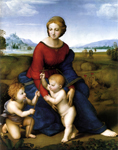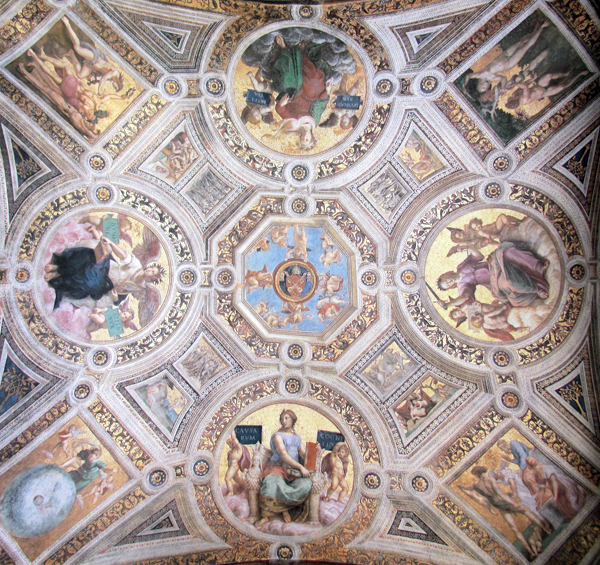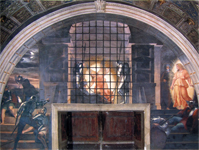Raphael in Rome
 |
| Madonna del Belvedere |
When Raphael was called to Rome by Pope Julius II, at the end of 1508, he was 25 years old, a few months before Michelangelo, 8 years elder than Raphael, was back in Rome after having fled in 1505, suggesting that Pope Julius II wanted him dead, and yet on behalf of that Julius II he was preparing to paint the ceiling of the Sistine Chapel.
The twenty-five Raphael was already famous as a painter of Madonnas and as a portraitist, giving Donato Bramante, architect of the Pope, born in Urbino as Raphael, the opportunity to support him.
So it was that Raphael had by Julius II, along with other great artists: the Sodoma, Lorenzo Lotto, Baldassarre Peruzzi, the commission to fresco the new papal apartments, which we now call the Stanze di Raphael.

The work began at the end of 1508 with the ceiling of the Room of the Segnatura, which was to be the library of the Pope, but that became the main seat of the ecclesiastical court, the “Segnatura Gratiae et Iustitiae”.
The Pope liked so much what Raphael painted, and it was the first experience of Raphael as fresco painter, that he commissioned Raphael all his apartment, ordering to destroy the existing frescoes of the fifteenth century. Actually Raphael saved the frescoes of his former master, Perugino and held Sodoma by himself.
Click on the navigable photo below and see in detail the ceiling:

Initiated in 1509, the frescoes in the Stanza of the Segnatura (Parnassus, the School of Athens, the Dispute of the Sacrament, Virtue and Justice), was completed in 1511.
The Stanza of the Segnatura was from the outset considered one of the finest examples of Italian art and gave Raphael the reputation of most famous living painter.
In Rome he met Agostino Chigi “The Magnificent”, who in addition to be rich was also one of the greatest patrons of the Renaissance and in 1511 Raphael painted in the villa of Agostino the famous Triumph of Galatea.
Began at that time a period of frenetic activity, on the one hand, Pope Julius II wanted Raphael to go on painting the Stanze, on the other private clients insisted on having at least one of his works and, finally, his insatiable curiosity led him to study and explore new experiences.
In the Roman period, ranging from 1508 to 1520, the year of his untimely death, we can identify different types of activity.
First, driven, as we mentioned, by his insatiable curiosity, he immersed himself in the study of Rome, that with all the impressive evidence of ancient art, deeply marked his artistic sensibility and a critical step in the evolution of the artistic career of Raphael was due to the recovery in 1506, at the Thermae of Titus, of the Laocoon Group, which Pope Julius II saved in the Vatican doing to bring in the Belvedere courtyard along with many other ancient sculptures, which Raphael could see while frescoing the Stanza of the Segnatura.
Much has been told about the influence of Michelangelo on Raphael, that, if there was, lies in the plastic torsion of the bodies, which Raphael sometimes occurs, although to a lesser extent compared to Michelangelo, but if we look at the first well-known works Michelangelo, as the Vatican Pietà (1497 - 1499), or David (1501 - 1504), or the Madonna of Bruges (1503 - 1505), there is no trace of these plastic torsions, whereas it is the highest expression just the Laocoon group, a Roman copy of a Hellenistic original of the second century b. C. attributed to the sculptor Agesander of Rhodes.
Michelangelo began work on the Sistine Chapel in the middle of 1508 and Raphael began the Stanze at the end of that year.
Therefore, it is plausible that both Michelangelo and Raphael have drawn inspiration from the Hellenistic art in general and in particular from the Laocoon, giving rise to representations consistent with their different artistic sensibilities.
Another episode no less important was the rediscovery of the Domus Aurea with its frescoes and decorations, the so-called grotesque. The Domus Aurea, together with the Thermae of Titus and the Pantheon was studied in depth by Raphael, who in the Vatican Loggias devised a decorative style based on stucco and grotesque inspired precisely by the Domus Aurea.
In that same time friendship with Bramante and the study of the Pantheon did discover Raphael spatial vision, which finds expression in the Stanza of the Segnatura in the fresco “The School of Athens”, where we see Plato and Aristotle to proceed within an architectural perspective.
 |
| Liberation of St. Peter |
To summarize to the group of the Laocoon Raphael pays the plasticity of its representations, to Bramante and the Pantheon the spatial vision, to the Domus Aurea not only the decorative style, but also the interpretation of the painting as a lively narrative.
Moreover, the innovative instinct led him to continue to pursue new ways and in the fresco of the Liberation of St. Peter in the Stanza of Heliodorus, we see the break of those contrasts of light that so influenced Caravaggio.
In the artistic activities of Raphael we can distinguish between those institutional, carried out on papal behalf, those made for Agostino Chigi and those non-institutional, he carried out for private clients.
Institutional activities were carried out for Pope Julius II and Leo X and behaved the decoration of the Stanza of the Segnatura (1508 - 1511), the Stanza of Heliodorus (1511 - 1514), the Stanza of the Incendio (1514 - 1517) and the Hall of Constantine, commissioned to Raphael in 1517 by Pope Leo X, for which Raphael prepared drawings and cartoons, but in 1520 his death occurred, so that it was painted by Giulio Romano, Giovanni Francesco Penni and aids.
When Bramante died in 1514, Pope Leo X commissioned Raphael to the supervision of works for the construction of St. Peter and the charge of "custodial and registration of antique marbles." Task that Raphael played with great commitment and allowed to save from destruction and dispersion countless sculptures. In this context, Raphael had proposed to build a plant of Imperial Rome, the result of systematic study of architectural structures, unfortunately his untimely death has deprived us of what would have been a major contribution to the knowledge of ancient Rome. Always Pope Leo X commissioned Raphael to the completion of the Loggias of the Apostolic Palace which Bramante had left unfinished and that Raphael decorated in the style borrowed from the Domus Aurea.
Finally he drew cartoons for the tapestries in the Sistine Chapel.
For Agostino Chigi he painted in his villa, which we now call the Farnesina Villa, the Triumph of Galatea, the Loggia of Cupid and Psyche and a banquet hall destroyed in the late nineteenth century during the channeling of the Tiber.
Furthermore, for Agostino, he designed the Chigi Chapel in Santa Maria del Popolo and frescoed the Sibyls and Prophets in the Chigi Chapel of Santa Maria della Pace.
For the non-institutional clients, in the Roman period, he painted more than 40 works on display for the most part in the most important museums in the world.
To support such an imposing and demanding body of work Raffaello co-opted in his shop, which initially worked at home, artists who dragged by the personality of the master expressed themselves in an extraordinary way.
Raphael's workshop was unique in its own way and certainly diametrically opposed to that of Michelangelo, whose aids were confined to the preparation of colors and plaster for the frescoes. On the contrary Raphael, delegating his aids significant parts of the works, favored their artistic growth, so that in his workshop developed their talents Giulio Romano, Lorenzo Lotti (the Lorenzetto), Giovanni da Udine, Perin del Vaga, Polidoro da Caravaggio, Giovanni Penni, Guillaume de Marcillat, Alonso Berruguete, Thomas Vincidor, Vincenzo Tamagni, Raffaellino del Colle. These aids were occasionally joined by artists and friends of Raphael, like Sodoma and Baldassarre Peruzzi.
back |

